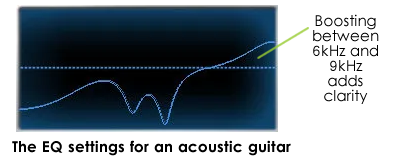A muddy tone refers to a lack of brilliance, midrange definition or treble definition. It’s the “blanket over an amp” sound.
A muffled sound simply means that the sound you’re hearing consists of a greater number of lower frequencies than higher ones. This problem generally occurs when you’re recording or playing live through a PA system.
 The obvious solution would be to use an equalizer to correct the inaccuracies, however it’s better to start at the source and work your way up from there.
The obvious solution would be to use an equalizer to correct the inaccuracies, however it’s better to start at the source and work your way up from there.
Unlike electric guitars, acoustic guitars are more prone to being affected by humidity and absorb more moisture. For acoustic guitars, a hygrometer can help to track humidity.
Strings can lose their brightness quickly due to high humidity and darken your sound. It’s a good idea to apply a new pair of strings to a clean fretboard. If new strings are subject to dirt, they will lose their sparkle quickly. Some string manufactures, like Elixir, include a protective coating to protect against corrosion.
For electric guitar, the amplifier cabinet plays a large roll in determining how bright your guitar tone is perceived. Therefore changing the cabinet would be a good start, before applying any equalization. Different microphone types also have different frequency responses.
You can improve your ability to adjust EQ on a site like SoundGym. SoundGym offers a variety of free exercises that can help you get better at using an EQ.
